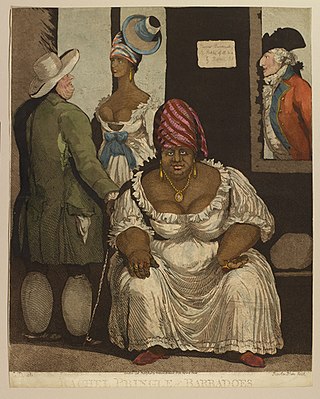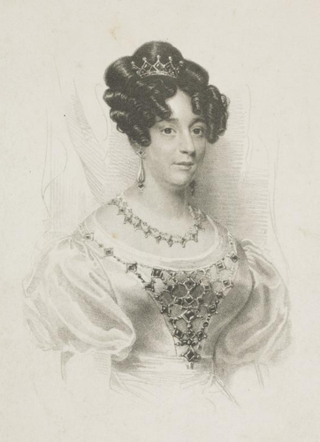Related Research Articles

Manumission, or enfranchisement, is the act of freeing slaves by their owners. Different approaches to manumission were developed, each specific to the time and place of a particular society. Historian Verene Shepherd states that the most widely used term is gratuitous manumission, "the conferment of freedom on the enslaved by enslavers before the end of the slave system".

Chatham Manor is a Georgian-style mansion home completed in 1771 by farmer and statesman William Fitzhugh, after about three years of construction, on the Rappahannock River in Stafford County, Virginia, opposite Fredericksburg. It was for more than a century the center of a large, thriving plantation and the only private residence in the United States to be visited by George Washington, Thomas Jefferson, Abraham Lincoln, and Dwight D. Eisenhower.

Barbadian nationality law is regulated by 1966 Constitution of Barbados, as amended; the Barbados Citizenship Act, as amended; and various British Nationality laws. These laws determine who is, or is eligible to be, a national of Barbados. Barbadian nationality is typically obtained under the rules of jus sanguinis, i.e. by birth to a father or in some cases, a mother, with Barbadian nationality. It can also be granted to persons with an affiliation to the country, or to a permanent resident who has lived in the country for a given period of time through naturalisation. There is currently no program in Barbados for citizenship by investment, though they do have a special work visa program. Nationality establishes one's international identity as a member of a sovereign nation. Though it is not synonymous with citizenship, rights granted under domestic law for domestic purposes, the United Kingdom, and thus the Commonwealth, has traditionally used the words interchangeably.

Partus sequitur ventrem was a legal doctrine passed in colonial Virginia in 1662 and other English crown colonies in the Americas which defined the legal status of children born there; the doctrine mandated that children of slave mothers would inherit the legal status of their mothers. As such, children of enslaved women would be born into slavery. The legal doctrine of partus sequitur ventrem was derived from Roman civil law, specifically the portions concerning slavery and personal property (chattels), as well as the common law of personal property; analogous legislation existed in other civilizations including Medieval Egypt in Africa and Korea in Asia.

Freedom suits were lawsuits in the Thirteen Colonies and the United States filed by slaves against slaveholders to assert claims to freedom, often based on descent from a free maternal ancestor, or time held as a resident in a free state or territory.
Fédon's rebellion was an uprising against British rule in Grenada. Although a significant number of slaves were involved, they fought on both sides. Predominantly led by free mixed-race French-speakers, the stated purpose was to create a black republic as had already occurred in neighbouring Haiti rather than to free slaves, so it is not properly called a slave rebellion, although freedom of the slaves would have been a consequence of its success. Under the leadership of Julien Fédon, owner of a plantation in the mountainous interior of the island, and encouraged by French Revolutionary leaders on Guadeloupe, the rebels seized control of most of the island, but were eventually defeated by a military expedition led by General Ralph Abercromby.
Judith Philip was a free, Afro-Grenadian business woman who amassed one of the largest estates in Grenada. By the time Britain emancipated slaves in the West Indies she owned 275 slaves and was compensated 6,603 pounds sterling, one of the largest settlements in the colony.
Marie Rose Cavelan was an Afro-Grenadian planter and revolutionary. A free woman of color, she married Julien Fédon, a French Catholic, like herself of mixed ancestry. Together, she and her husband bought a plantation and engaged as planters and slave owners in the colonial period.
Amaryllis Collymore (1745–1828) was an Afro-Barbadian slave who gained her freedom from her relationship with a white man. The couple had eleven children and she successfully ran a plantation allowing her to acquire numerous other properties, to become the wealthiest free black woman in the colony at the time of her death.
Rosetta Smith was an Afro-Trinidadian slave trader and entrepreneur. Because of her association with Thomas Picton, the governor of Trinidad accused of abuse against a slave, she has come down in history as a seductress and sinister woman who used her wiles to manipulate the governor. A reexamination of her life indicates that she was an astute businesswoman who was successful in enlarging her fortunes over at least three decades.

Rachael Pringle Polgreen (1753–1791) was an Afro-Barbadian hotelier and brothel owner. Born into slavery, her freedom was purchased, and she became the owner of the Royal Naval Hotel, a brothel that catered to the itinerant military personnel on the island of Barbados.
The Guardian of Sally v. Beatty was a 1792 court case decided in the Supreme Court of South Carolina. A jury charged by Chief Justice John Rutledge held that a slave who had been bought and manumitted by another slave was free, not the other slave's owner's property.
Dorothy Thomas was a Caribbean entrepreneur and former slave who engaged in business in Montserrat, Dominica, Grenada, Barbados, and Demerara. Having purchased her own manumission, Thomas spent nearly sixteen years securing the freedom of her children, mother, and several other relatives. Though she owned hotels one of which had a French restaurant, her primary source of income was hiring out female hucksters to whom she supplied goods to be sold to plantation workers and slaves. She also hired out her slaves as labourers, earned income from lodging houses, ran a plantation, and rented out properties which she owned. Known as one of the few black women who derived compensation from the government scheme to reimburse slave owners, she received £3,413 for the loss of her labourers when Britain abolished slavery.
Dorothea Christina Thomas was a free woman of colour and slave owner from Grenada, whose common-law marriage with Major John Gordon became the centre of a Scottish legal case. It set an important precedent defining the circumstances under which a marriage could be established by "habit and repute" in Scotland and is illustrative of the challenges encountered in family law prior to the establishment of uniform reciprocity agreements regarding marriage recognition. Her relationships also refute the notion that free women of colour were merely mistresses and confirm that there were various types of relationships in her era that mirrored stable marriages.
Nancy Clarke was a Barbadian hotelier and free woman of colour who was known for the continued success of the Royal Naval Hotel. According to Professor Pedro Welch of the University of the West Indies, Clarke's history is indicative of the ingenuity Barbadian women of colour used in the 19th century to secure emancipation from slavery for themselves and others.

Henrietta Simon Sala, known as Madame Sala, was a British concert singer and salon holder. She was a free woman of colour from the Dutch Colony of Demerara. She was sent to England to attend school before she was ten years old and as her father lost his fortune, she stayed there for the rest of her life. She became a music teacher and performed on the London stage, appearing at venues including Covent Garden, the St James's Theatre, and the Haymarket Theatre.
Elizabeth Swain Bannister was a free woman of colour from Barbados. She gained her freedom when her aunt Susannah Ostrehan manumitted her in 1806. She later moved to Berbice where she lived with her partner William Fraser, conducting business in her own right. She acquired property and over 75 slaves, leaving a legacy to her children, who had been legitimized by their father, of £5,400,

Cariye was a title and term used for category of enslaved women concubines in the Islamic world of the Middle East. They are particularly known in history from the era of the Ottoman Empire, where they legally existed until the mid-19th century.

In ancient Rome, contubernium was a quasi-marital relationship between two slaves or between a slave (servus) and a free citizen who was usually a former slave or the child of a former slave. A slave involved in such a relationship was called contubernalis, the basic and general meaning of which was "companion".
Joachim Philip was a Grenadian planter and revolutionary, and a member of the prominent free-coloured (mixed-race) Philip family. He was a leader of Fédon's rebellion; Philip held the rank of captain in Julien Fédon's forces and delivered Fédon's ultimatum to the British forces in St. George's. He survived the end of the rebellion but was captured in Petit Martinique eight years later and executed.
References
- ↑ Candlin, Kit; Pybus, Cassandra (2015). "A Lasting Testament of Gratitude: Susannah Ostrehan and her nieces". Enterprising Women: Gender, Race, and Power in the Revolutionary Atlantic. University of Georgia Press. p. 87.
- ↑ Candlin & Pybus (2015), p. 88.
- 1 2 3 Candlin & Pybus (2015), p. 89.
- ↑ Candlin & Pybus (2015), p. 83.
- ↑ Candlin & Pybus (2015), p. 80.
- ↑ Candlin & Pybus (2015), p. 92.
- 1 2 Candlin & Pybus (2015), p. 90.
- ↑ Candlin & Pybus (2015), p. 82.
- ↑ Candlin & Pybus (2015), p. 99.